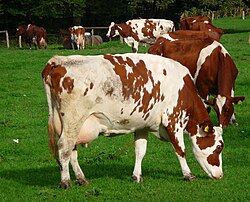
Back رعي Arabic Pasturatge Catalan Pastva Czech Paŝtado Esperanto Pastoreo Spanish Artzaintza Basque Pastoreu EXT چرا Persian Laidunnus Finnish Pâturage (alimentation) French

In agriculture, grazing is a method of animal husbandry whereby domestic livestock are allowed outdoors to free range (roam around) and consume wild vegetations in order to convert the otherwise indigestible (by human gut) cellulose within grass and other forages into meat, milk, wool and other animal products. Grazing is often done on lands that are unsuitable for arable farming, although there are occasions where arable lands and even prior farmlands are intentionally kept or converted to pastures to raise commercially valuable grazing animals.
Farmers may employ many different strategies of grazing for optimum production: grazing may be continuous, seasonal, or rotational within a grazing period. Longer rotations are found in ley farming, alternating arable and fodder crops; in rest rotation, deferred rotation, and mob grazing, giving grasses a longer time to recover or leaving land fallow. Patch-burn sets up a rotation of fresh grass after burning with two years of rest. Conservation grazing proposes to use grazing animals to improve the biodiversity of a site. [1]
Grazing livestock on open grasslands, i.e. pastoralism, has existed as a human practice since the beginning of agriculture; sheep and goats were domesticated by nomads before the first permanent settlements were constructed around 7000 BC, enabling cattle and pigs to be kept, and people who supervise grazing livestock are called shepherds. In the vast Eurasian steppe, migrating and grazing herds of sheep and horse between different pasture regions had been the primary means of food production for the Inner Asia horseback nomads, with many nomadic empires rose and fell throughout history until the early modern period. During the late Medieval and early modern England, many common lands used by peasants for crop farming were enclosed and converted to pastures controlled by gentries to favor wool trades. In modern era, ranching is the more common method of raising grazing livestock, although artificially made feeds such as hay and fodders are sometimes used to supplement grazing.
Livestock grazing contributes to many negative effects on the environment, including deforestation, extinction of native wildlife, pollution of streams and rivers, overgrazing, soil degradation, ecological disturbance, desertification,[2] and ecosystem stability.[3][4]
- ^ Filazzola, A.; Brown, C.; Dettlaff, M. A.; Batbaatar, A.; Grenke, J.; Bao, T.; Peetoom Heida, I.; Cahill Jr, J. F. (2020). "The effects of livestock grazing on biodiversity are multi-trophic: A meta-analysis". Ecology Letters. 23 (8): 1298–1309. Bibcode:2020EcolL..23.1298F. doi:10.1111/ele.13527. PMID 32369874. S2CID 218521073.
- ^ "Grazing". www.biologicaldiversity.org.
- ^ Liang, M. (2021). "Grazing-induced biodiversity loss impairs grassland ecosystem stability at multiple scales". Ecology Letters. 24 (10): 2054–2064. Bibcode:2021EcolL..24.2054L. doi:10.1111/ele.13826. hdl:1874/418875. PMID 34319652.
- ^ Hautier, Yann; Van der Plas, Fons (2022-02-16). "Biodiversity and Temporal Stability of Naturally Assembled Ecosystems Across Spatial Scales in a Changing World". The Ecological and Societal Consequences of Biodiversity Loss. Wiley. pp. 189–209. doi:10.1002/9781119902911.ch9. hdl:1874/427826. ISBN 978-1-78945-072-9. S2CID 246920767.